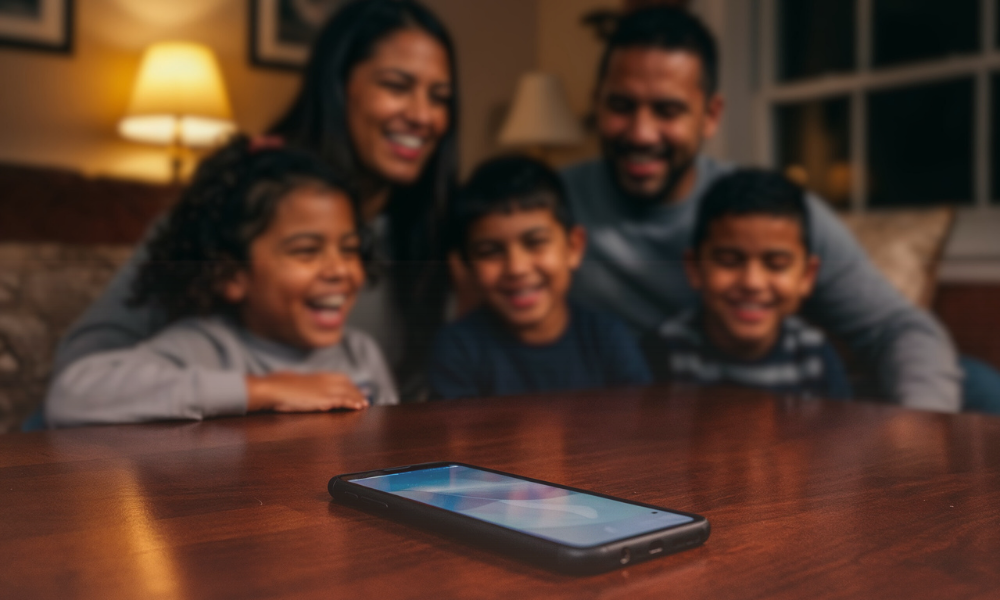Screens are everywhere—from homework to downtime—and it’s getting harder for families to stay connected without them. Maybe it starts with one more show before bed, or background scrolling during dinner. Over time, tech becomes the default instead of the exception. Creating digital balance for the whole family means noticing those patterns and finding a rhythm that works without turning every moment into a power struggle.

Digital devices are here to stay, but screen time struggles don’t have to be. This post offers practical, age-flexible ways to reduce tech tension and help your kids build mindful digital habits—without guilt, overwhelm, or constant reminders.
Start With Shared Values, Not Just Rules
Before jumping into time limits or app restrictions, pause and reflect as a family:
- What role do you want tech to play in your home?
- Is it a tool for learning, connection, or creativity?
- What does too much screen time feel like?
When kids get a say in how your family handles screens, they’re more likely to cooperate. One recent report even found that children respond better when they’re included in the conversation instead of just being told what to do (Organisation for Economic Co-operation and Development [OECD], 2023).

Try This: Ask your child, “What would a healthy tech day look like for you?”
Reflect: Do your current family rules reflect your real priorities—or just default habits?
Build a Simple Tech Routine That Actually Works
Strict screen schedules often fall apart under real-life pressure.
Instead, try building around natural daily anchors like school, meals, and bedtime.
You might allow free time after homework but keep screens off during dinner and the hour before bed.
Here’s how screen guidelines can flex by age:
- Ages 3–6: Keep it short, co-view when possible, and prioritize interactive shows or learning apps.
- Ages 7–10: Use visual timers or checklists to make limits clear and predictable.
- Ages 11–14: Involve your tween in the decision-making—especially around gaming or social media.
Try This: Create a “Tech Use Today” tracker that includes checkboxes for movement, creativity, and screen-free play.
Reflect: When is your child reaching for a screen out of habit rather than intention?
Model the Habits You Want to See
Kids learn more from what we do than what we say. If you’re scrolling through your phone at the dinner table, they’ll notice. Practicing digital balance as a parent sends the strongest signal.
A 2025 study found that when parents are frequently distracted by their devices—a phenomenon called “technoference”—it can impact children’s emotional well-being, focus, and behavior. The researchers emphasized that consistent, face-to-face connection helps kids thrive (University of Wollongong, 2025).
Even small changes like setting your phone aside during family time can have a long-term impact. For more strategies on tech modeling, check out Teach Your Kids Digital Safety With Confidence.
Try This: Designate one daily “device-free zone” e.g., the dining area or your child’s bedroom.
Reflect: How are your tech choices shaping the habits your child is building?
Revisit and Adjust as They Grow
Creating digital balance for the whole family isn’t a one-time conversation—it’s an evolving process. As your child grows, so will their digital needs and interests. Stay open to revisiting your family’s expectations every few months.
Let your child share what’s working and what feels frustrating.
Problem-solve together, not just from the top down.
Building trust around tech decisions often works better than using screen time as a reward or consequence.
Not sure what’s developmentally appropriate? Explore Screen Time Rules by Age: What Parents Should Know for age-based guidelines you can personalize.
Try This: Schedule a 10-minute monthly “tech check-in” with your child.
Reflect: What do you want your family’s relationship with technology to look like in 5 years?
Frequently Asked Questions
Q: What if my child melts down when screen time ends?
A: Give advance warnings using a visual timer. Stay consistent and pair transitions with engaging alternatives like music, drawing, or movement.
Q: How much screen time is okay each day?
A: The American Academy of Pediatrics recommends no more than 1 hour daily of high-quality content for ages 2–5. For older kids, consistency and co-viewing matter more than a rigid number.
At Parent Pathways Academy, we believe creating digital balance for the whole family is possible with patience, flexibility, and a lot of conversation.
When you lead with values and connection, healthier tech habits are more likely to last.
Want tools you can use right now? Download the PPA app today! It’s your go-to resource for creating digital balance for the whole family, featuring tips, routines, and age-specific tools to guide your journey.

References
Organisation for Economic Co-operation and Development. (2023). Empowering young children in the digital age. OECD Publishing. https://www.oecd.org/en/publications/empowering-young-children-in-the-digital-age_50967622-en.html
University of Wollongong. (2025). Parents’ obsessive technology use may have serious long-term effects on babies and toddlers: study. Retrieved from https://nypost.com/2025/05/06/lifestyle/parents-obsessive-technology-use-may-have-serious-long-term-effects-on-babies-and-toddlers-study/

